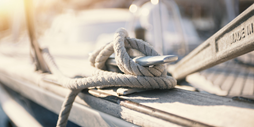WHAT YOU NEED TO KNOW ABOUT MOORING EQUIPMENT MAINTENANCE
11-01-2024
Mooring equipment plays an important role in facilitating the safe operation of a vessel in port. To keep tools and machinery in top condition, it’s crucial to ensure equipment is regularly checked and maintained. Read on to discover everything you need to know about mooring equipment maintenance.
CHECK EQUIPMENT PRIOR MOORING
After extended sea passages or voyages undertaken in heavy seas, it’s important to check equipment before mooring. You should ensure that you examine:
Any physical damages to the mooring mechanism
All controls, linkages and the operating levers are well oiled, greased and easy to use
Brake drums and linings are suitably dried and cleared of salt deposits
CARRY OUT FREQUENT GREASING OF MOVING PARTS
All rotating parts of the mooring equipment should be moved and lubricated on a frequent basis. This includes rollers, fairleads, winch drums and deck stands. You can use multipurpose grease and high pressure grease guns to carry this out. Remember, you should pay particular attention to roller fairleads and deck stands – these often suffer from little use and are therefore neglected. Make sure rollers turn smoothly and are checked for integrity, as corrosion may have weakened them.
INSPECT BRAKE LINERS
You should regularly inspect the winch/windlass linings for wear and tear. This is because oil, heavy rust and moisture on the brake linings or the drums could seriously reduce the brake holding capacity of the winch – in some cases, this could extend to as much as 75%. To remove the moisture in the linings, apply the brakes lightly while running the winch. Oil, on the other hand, is more difficult to remove, and you may need to change the lining completely.
EXAMINE BRAKE DRUMS AND LINKAGES
Whenever brakes are opened for any reason, it’s important to make sure that the drum is thoroughly checked for build-up of rust or other material. It may need to be descaled and fitted with a replacement. Additionally, the brake linkages should be checked for free movement, as if the linkages are not free then this would signify a loss of brake holding capacity.
ENSURE A CLEAR WALKWAY
When undertaking mooring operations, it’s important that the deck is completely free of all obstructions and oily residues. This means decks will need to be kept clean and dry – if possible, it’s a good idea to have anti-slip paint coatings over the deck surface. It is additionally crucial to ensure that support brackets for the gratings, which are used in winch operations, have not been neglected and are therefore heavily corroded. This can make areas unsafe to step on – to reduce the likelihood of this, it’s advisable that these areas are consistently maintained.
Here at Atlas Winch & Hoist, we understand the importance of having good quality mooring equipment. From your mooring buoys to your locks and fittings, we have a range of products to suit your vessel perfectly. For information on marine winches and more, please email us at info@winhhire.com or call us on 01899 221 577.






